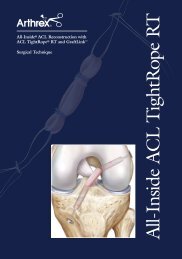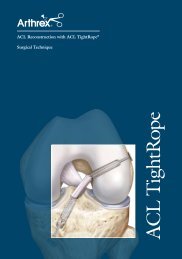Materials - Sumisan SA
Materials - Sumisan SA
Materials - Sumisan SA
You also want an ePaper? Increase the reach of your titles
YUMPU automatically turns print PDFs into web optimized ePapers that Google loves.
310 A. WEILER ET AL.<br />
FIGURE 6. CT scan showing severe osseous sclerosis of an<br />
implant site 18 months after metaphyseal implantation of PLLAco-PDLLA<br />
pins in a sheep.<br />
with high molecular-weight PLLA screws. 56 In a study<br />
of MRI scans, they found that no osseous replacement<br />
of the implant had occurred up to 6 years after<br />
implantation (Fig 10). Pistner et al. 47 studied the<br />
intraosseous long-term fate of injection-molded PLLA<br />
and PLLA-co-PDLLA screws inserted in the femur of<br />
guinea pigs. After implantation of 150 weeks, they<br />
found that osseous replacement of the former implant<br />
site had occurred and, therefore, stated that amorphous<br />
polylactides are fully biodegradable materials. However,<br />
even for faster-degrading implants, the process of<br />
osseous replacement may require several years if there<br />
has been evidence of an osteolytic lesion during the<br />
final stage of degradation (Fig 12).<br />
BIOCOMPATIBILITY AND CLINICAL<br />
CLASSIFICATION OF TISSUE RESPONSE<br />
Since the mid 1960s, many studies have been<br />
performed to evaluate the suitability of various synthetic<br />
biodegradable polymers. Prompted by the results<br />
arising out of these investigations, biodegradable<br />
implants for various orthopaedic procedures have been<br />
introduced. However, the biocompatibility of these<br />
materials is still controversial.<br />
The degradation process and tissue response have<br />
been documented by many authors. These studies<br />
show that biodegradable poly-�-hydroxy acids cause<br />
mild, nonspecific tissue response with fibroblast activation<br />
and the invasion of macrophages, multinucleated<br />
foreign-body giant cells, and neutrophilic polymorphonuclear<br />
leukocytes during their final stage of degradation.<br />
47,48,51-53,57-62 The initial euphoria arising out of<br />
excellent clinical results was abated by the first reports<br />
of foreign-body reactions with biodegradable implants<br />
in fracture treatment. In 1987, Böstman et al. 63 re-<br />
FIGURE 7. Implant site after<br />
18 months of implantation of a<br />
self-reinforced PGA rod. Slow<br />
bony formation at the margin of<br />
the implant site; tetracycline labeling<br />
(arrows) 12 months before<br />
harvesting the knee (fluorescence<br />
microscopy with an<br />
almost selective tetracycline presentation).




